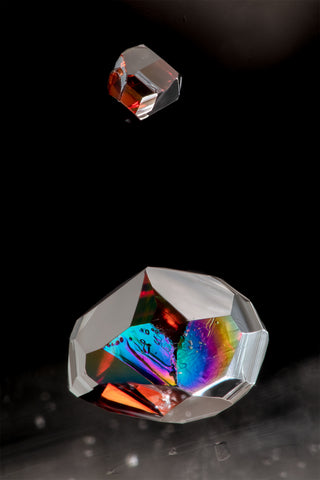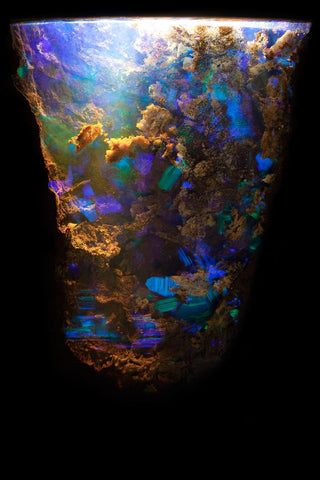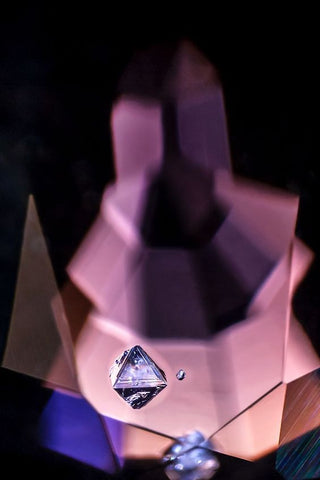Hey Loungers,
Today we have the pleasure of restarting an arc that we began a few years ago with E.Billie Hughes. Today, we are blessed with the presence of the Space Enchanter: Danny Sanchez!
We discovered Danny’s work a few years back as we were discussing photomicrography with some of his peers here in Bangkok.
Since then, we have had the pleasure of purchasing a few of his shots and finally met him before the COVID folie really kicked in on a world-wide basis at Tucson 2020.
Today, we are given the opportunity to discuss his path, his art and his passion and hopefully learn a bit more about the man behind the scope!
Danny, the floor is yours,
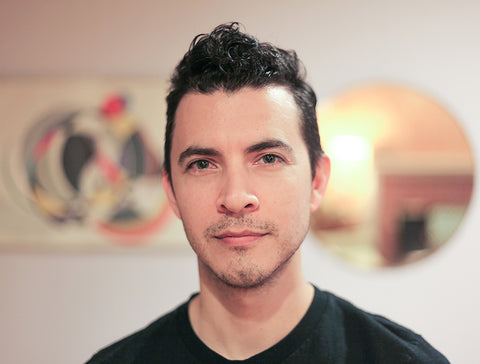
Danny Sanchez is with us in the Lounges - Photo Credits: Danny Sanchez
AsiaLounges: Hi Danny, thank you very much for being with us today! We’ll start soft by figuring out a bit more about you. Who are you Danny Sanchez?
Danny Sanchez: My pleasure. Thanks for reaching out!
I grew up in Los Angeles, California raised by two teachers, in a house where I was always encouraged to try different things and felt supported in my endeavors. From a very early age I studied music and later, my life revolved around performing. That certainly shaped a large piece of my personality.
I’ve always been curious and I’m always tinkering with something. I have a high metabolism and (as we say in the States) “busy hands” so I'm usually up to no good.
So I guess all that adds up as: jack-of-all-trades, sensitive artsy types. Is that a good summary? Ha!
AsiaLounges: How did you enter the world of gems and jewellery? I understand that you work for a jewellery company in California, is it a family business that got you started or is the love for shiny rocks a later encounter?
Danny Sanchez: I am in the jewellery business, yes. Though it's not something I'd have ever predicted, as I have no familial connection to the business.
As I mentioned, my parents were both teachers and I was, for most of my life, a musician. It was only until I began feeling burnt-out on the life of a gigging musician that I started looking for other career paths.
When I heard that one could study "gems" (gemmology), I was immediately interested. From a very young age light and color captured my imagination. I had quite a horde of glass objects, pieces of costume jewellery, prisms, those types of things. I think if gemmology had been placed on my radar earlier I definitely would have gone straight for it. Even growing up in LA where we have a fantastic natural history museum with its own gem vault (which, even now, is the closest thing I have to a holy place), studying gems and minerals was never introduced to me as a potential path.
Once I discovered GIA, it was a no-brainer. I enrolled, passed all my classes and loved every minute of it. Apparently I had an aptitude for it because the director of the LA campus set me up with a job interview at the GIA Carlsbad campus where I worked for a year or so. That's when I heard of a job opening at an estate/antique jewellery store back in LA at which I promptly interviewed and was offered a job.
Here is a lovely Mexican opal picture that welcomes every single one of our guests as they enter the Lounges. Picture can be purchased here from Danny J Sanchez
AsiaLounges: Heading into the topic of photography and most particularly inclusion photography. You are known as a master of space when it comes to photography and many have seen, purchased or at least heard of your work. That said, I suspect that fewer are those that know how you got to start to hone your skills and begin in your art. Could you tell us what got you started?
Danny Sanchez: When I was a gemmology student, of course I was introduced to the wonders of John Koivula's photomicrography and the wheels of my imagination were definitely set in motion. However, it was only when I was working in Carlsbad - spending every day in the scope, getting comfortable with the stones and lighting - that I began to get a sense that photomicrography was something I wanted to try, in earnest.
So really, it was my (somewhat brief) tenure working for the GIA where my love for the microscope and the escape that it offered solidified.
However, I soon became made aware of the high cost of entry to a project like that - and I'll cover that in a moment.

What do you think of this cave like scenery? Doesn't it remind you of Dagobah, Yoda's last home? - Photo Credit: Danny J Sanchez
AsiaLounges: When it comes to photography we often hear that light is the most important element yet, regardless of tools or light sources few are those that manage to bring up that impression of space that you systematically provide with your shots. Why is that? Is it due to a particular sensibility that only you and other select few have or is there a more technical aspect that most forget to play with?
Danny Sanchez: It’s definitely more on the sensibility side, although technique helps. I think the answer lives somewhere within “why I do this in the first place”.
Growing up as a child of sci-fi, my mind was always reaching for “other” places to play in / experience. Those places, however, were always fictional. That is - until I discovered the worlds within gems… the first time I saw a Koivula photomicrograph.
The wholly unique wonder I felt when I first understood that these perfect, tiny worlds lived within gems (GEMS!) could be seen and photographed, I was infected. Infected with the desire for “more”. Not just more photos but more feeling. How often do we as humans have a chance to see something entirely new? Images from telescopes and space probes and maybe a nature documentary but that’s it. But as photomicrographers we get to discover entire landscapes never before seen by human eyes.
This fueled my constant desire to be in the scope. I wasn’t looking for inclusions or unique associations, I was chasing the ephemeral moment of undiluted awe in response to a truly novel sight.
I couldn’t have articulated that at the time, though. I didn’t even know it myself. Early on, I thought I was just taking photos of inclusions. But when I look back on my early photos, I see the nascent attempts at framing the space; creating atmosphere rather than simply photographing inclusions.
So while composition, lighting techniques, choosing how to facet and polish the stone, and the complexities of focus stacking are important to all of my photos - the intention every time I sit down to photograph a stone is to find the scene that fills me with the most awe.
AsiaLounges: Contrary to your fellow Microteers (Lotus Gemology’s E. Billie Hughes and GIA’s Nathan Renfro) you seem to shun precious gems in your shots in favour of quartz and more recently opals. Is there a particular reason besides your particular affinity for said materials?
Danny Sanchez: The presupposition here is that I have the broad, continuous access to precious stones in the way that Billie and Nathan do and that for some arcane reason I “shun” them.
I’m wholly unaffiliated and have to source and purchase all my stones. When I have to buy my own materials (and I know from experience that one stone doesn’t necessarily equal one photo) I can either buy one stone for X dollars or 10+ stones for the same amount.
It should be said that there are so many generous people in my life who would loan me anything I asked for (Nathan is one of those people and so are you!). But I rarely take them up on that offer for a couple of reasons. Mostly because I work on my own schedule and sometimes that can be very slow and I’d really rather not tie up anyone’s inventory. It can be months sometimes and I feel that’s just taking advantage of people’s kindness. There’s also a liability issue and I’d rather not take on more of that than I have to.
Now - it just so happens that the landscapes inherent in almost all opals in matrix really inspire me and set my imagination on fire. For my money, there isn’t a more dynamic, novel stone for photomicrography than precious opal in matrix and particularly those from Mexico. That said, if I had the kind of access that Billie and Nathan do, I’m sure you’d see a lot more shots of sapphires and spinels and emeralds, etc. </wink>
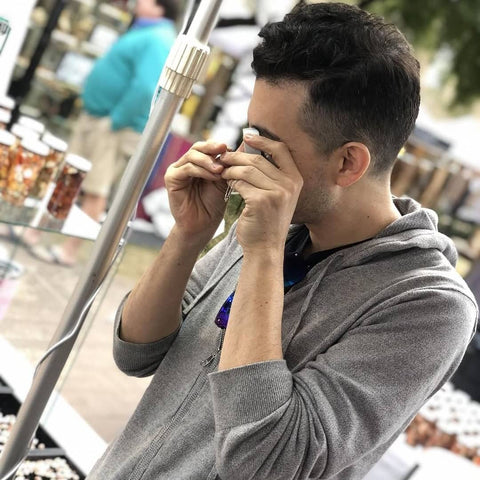
Here is Danny shopping for gems in Tucson, Az - Photo Credits: Danny J Sanchez
AsiaLounges: This question is almost the caricature of one but, given the recent multiplication of microphotography posted online and on social media one must wonder, how does one make the difference between a good photomicrograph and a bad one? Are their specific codes that one must respect when taking a shot, much like in any other art forms, or is it purely aesthetics?
Danny Sanchez: The answer to the second question is this: A photomicrograph is just a photo. If that photo is taken for scientific purposes, there should be an attempt to stay as true to the view through the oculars as possible.
If the photo is taken for any other reason, no, there shouldn’t be any rules or restrictions. Some believe it’s possible to objectively critique artistic works if one knows the artist’s intention. Others believe art can be judged simply on its impact.
I’m interested in either of these conversations (and more) but have yet to come to any hard conclusion. The most compelling factor when I am judging something “good” from “bad” is definitely intention but I make no claims as to whether my approach is better or worse than any other.
Negative crystal in a purple spinel by Danny J Sanchez
AsiaLounges: I always hear people asking you, Billie or Nathan about equipment and whether it makes a real difference in your art. While I suppose that it does to an extent I’d very much like to hear your opinion on the subject. Is the photographic equipment really paramount to taking a great shot or is it a more common misunderstanding, a common excuse beginners use to explain their early lack of results?
Danny Sanchez: Yes and no. Assuming that, indeed, good lighting is the most important piece of equipment necessary, any camera and any microscope will take a compelling shot as long as you have enough, balanced light. However, like any other craft - from cooking to carpentry, the more knowledge/skill you gain, the better the tool you want in your belt.
The issue with photomicrography is that each piece of equipment feels like it is more expensive than the last. Add that to the cost of the stones and peripherals, it is so hard as a beginner to feel like you can ever afford to buy “intermediate” or “advanced” level equipment. Speaking for myself, it was incredibly difficult to buy my second microscope and camera because while the first were inexpensive, in order to “advance” to better equipment I was facing thousands of dollars worth of upgrades. This field has a very high “cost of entry”.
I receive many emails asking for advice on this subject and while it’s easy enough to point people toward the appropriate equipment, they’ve got to decide if a fun/enticing hobby is worth the steep price.

Danny's photo set up, one understand why he mentioned the prohibitive cost of entry into this category - Photo Credits: Danny J Sanchez
AsiaLounges: Further to that last question and the one about a good and bad photomicrograph, what makes, in your opinion, people like yourself, your fellow Microteers or the Legendary John Koivula, tower above the majority of other photomicrographers? What makes the difference, in your opinion between an average photomicrographer and an Apex Predator in that peculiar field?
Danny Sanchez: You sure know how to craft a compliment.
With as much humility as I can throw against that question…
I’m a good technician, a good photomicrographer but obviously there’s more to it.
As I mentioned, a “successful” photo of mine must elicit the awe of discovery that I feel when I’m in the scope looking for the shot - and find it. My hope is that when people look at my work they feel similarly and I think that is where I excel.
That said, I have to point to the place of privilege that has allowed me the time and money to pursue all of this. Without the extra time at night and the salary I earn at my day job, there’s no way I could have excelled at this. I’m sure I’d have still tried but time and money certainly have given me an advantage. I’ve seen several talented photomicrographers in the past 5 years stop shooting because of financial or personal obligations. Who knows what they could accomplish, given the opportunities I’ve had.
AsiaLounges: Should you be free of any and all monetary concerns and other marketing issues and could focus on only one type of gems for the rest of your career. Which one would it be and why?
Danny Sanchez: All opal in matrix from all sources. Experiencing and capturing the dynamic three-dimensionality of play-of-color in opal is, hands down, the most exciting aspect of any stone I’ve seen. Couple that with the inherent landscapes of shooting material “in matrix” and the effect is an order of magnitude more exciting and fulfilling.

Ghost in the shell by Danny J Sanchez
AsiaLounges: As one of the rare people I know that also deal in retail and, even more so in California, I’d like to hear your opinion on the topic of ethics and transparency. Is it, in your opinion, something that the trade really needs or is it yet an another way to impose imperialistic views from one side of the planet onto the other? Does it really serve the intended purpose of helping the people it is set to help or is it yet another useless band aid, some would rather call it an ethical sticker, on western guilty conscience?
Danny Sanchez: I’d love to be able to speak with any kind of confidence on that subject but I’m in a corner of the gem and jewelry business that is very far removed from the types of systems you’re referring to. In the estate business we trade in finished jewelry that’s already been bought and sold several times over. Transparency and ethics, as they relate to the rough and finished stone trade, feel like a million miles away from the estate side of the jewelry business.
AsiaLounges: We are slowly reaching the end of this interview and, as per usual, I’d like to ask you to provide our readers, the Loungers, who’d like to follow in your footsteps with three pieces of advice and three books that you believe they should really have in their library.
Danny Sanchez: First and foremost everyone should keep the book that consistently inspires them to create close at hand. That can be anything from a work of fiction to a collection of works from their favorite artist.
Next should be the book (or piece of media) against which they sharpen themselves. Something that challenges them to be better than they were the day before.
And since we’re talking about “my footsteps”, certainly the Photoatlas of Inclusions in Gemstones. I prefer the second volume for its variety of hosts and inclusions as well as its healthy preface regarding photomicrography itself.
And my three pieces of advice are:
Never be too proud or too scared to ask questions - of anyone. The worst thing that can happen is that someone is rude to you - and that’s their problem, not yours.
Buy double the light you think you need.
Photomicrography of gems is a time consuming, expensive endeavour. That’s the reason so few people do it. It’s just as demanding as any other specialized skill or craft. You must love it in order to get to a point where you’re producing images you like. I spent years quietly practicing and honing my skills and aesthetic. It was difficult and struggled and early on I even quit because I was so discouraged. But I love it. And when you love a thing - you should keep at it because finding something you love doing is a rare thing.
Additionally, following sites were and remain crucial to my development:
www.photomacrography.net - the most info anywhere on the web for macro and micro.
www.savazzi.net - a treasure trove of research and documents from a dedicated man and his love for macrophotography and its history.
www.gemologyonline.com - Before fb groups overtook the world, and everyone could give their unfiltered two cents, this site was indispensable for me. I could ask almost any question and I was guaranteed that it would get attention and thought. It’s still a very valuable source of information. I have found that because it’s very well managed and there is a little extra effort in signing up and visiting - the quality of information is high and the excess “noise” is kept to a minimum.
AsiaLounges: Last but not least, where can the Loungers follow your art, how can they contact you and where can they purchase some of your beautiful photomicrographs?
Danny Sanchez: My instagram is, so far, the best, most up-to-date place to find my work. Dannyjsanchez.com is always there to check on articles and see a good example of my works. Recently Cartier featured many of my images in their book Magnitude - if you have access to that, check it out!
AsiaLounges: Thank you very much Danny for being with us today, I am convinced that our readers, the Loungers, have enjoyed this interview as much as we did enjoy writing these lines.
As for us, we will meet you again soon in the Lounges with more exciting content! If you have enjoyed this interview please let us know by liking, commenting and sharing our work with your family and friends on your favourite social media platform. Don't forget that you can also support A Gem Dealer's Journal through our Patreon's Page. It helps us a lot and takes but a second!
Should you have any questions or topic that you’d like us to research for a future interviews and articles, feel free to let us know by contacting us at simon@asialounges.com, it is always a pleasure to dig further into the world of gems and gemmology!
For all the rest, feel free to take a look at our gem and jewellery collection as well as to contact us should you be interested in getting one of our famed bespoke pieces of AsiaLounges Jewellery.
See you again in the Lounges,

